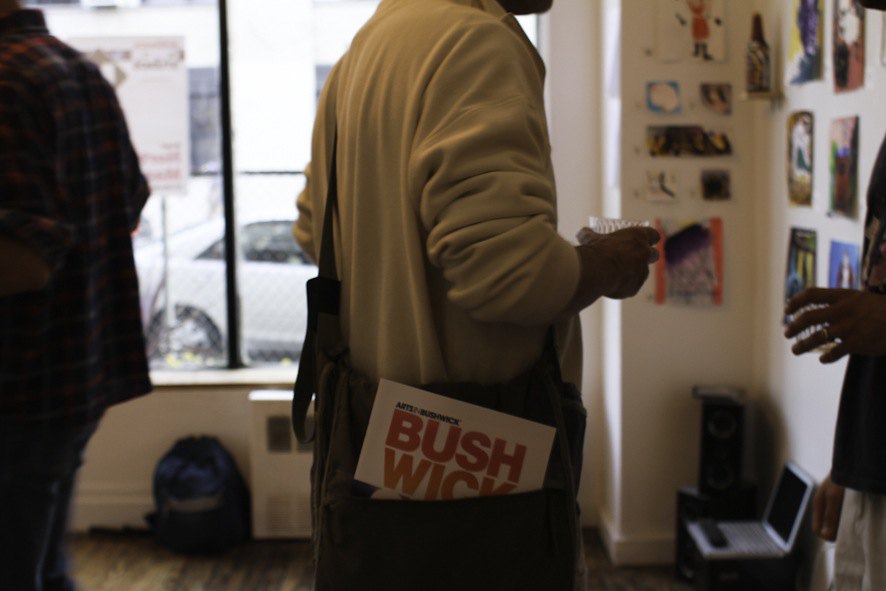
A weekend-long annual celebration of the neighborhood’s unbounded creativity, festival Bushwick Open Studios is coming to its 7th year. Needless to say, a lot has changed in the neighborhood since 2006 when the festival was held for the first time. However, the self-curated festival keeps growing while operating within the loose framework of an anti-institutional, egalitarian, volunteer organization of Arts in Bushwick.
The self-curated, grassroots community event has become a staple to the neighborhood, and has no comparable counterpart anywhere in New York City. “The energy of Bushwick Open Studios is very different and very unique,” says Julia Sinelnikova, one of the lead organizers of BOS who has also worked on Gowanus Open Studios, or Go! Brooklyn.
According to their website, Arts in Bushwick is an “all volunteer organization that serves and engages artists and other neighborhood residents through creative accessibility and community organizing.” AiB does not have a hierarchy, and anyone can join and take on a leadership role. “You can do whatever you want, as long as you actually do the work,” another lead organizer of BOS, Lucia Rollow, told us. “That’s how I got involved – I came to a meeting, and it blew my mind.” Arts in Bushwick is not a 501(c)(3) nonprofit organization; it is an incorporated business operating through a fiscal sponsorship. The organization holds weekly meetings of three parallel working groups (organizational, editorial and community oriented). “The decision-making happens mostly through discussion,” Julia said. “We are also using our past decisions as guidelines, and are trying to stick with the mission to the highest possible extent.”
The definitions and the rules of participation in BOS are fairly loose and have hardly changed since 2007. Julia Sinelnikova is absolutely convinced that it is the looseness of the organization and its rules that has allowed for the amazing diversity of the festival. According to the rules of BOS, anyone can register. Not only do you not have to live or work in Bushwick, you don’t even have to make “art,” per se. “Only a small percentage of people who live in this neighborhood have something to do with arts,” said Julia. “Thanks to this loose definition we have witnessed amazing things pop up in the streets.” It is true that the business owners, artists and community members are working together, exercising their creativity and this year we will witness among other things, a sculpture park on the Boar’s Head owned Rock Street, or a block party in front of Pine Box Rock Shop.

The only limitations are that the programming has to occur within the festival boundaries (which extends beyond Bushwick, including parts of East Williamsburg, Bed-Stuy, Maspeth and Ridgewood) and during the festival days (May 31-June 2, 2013). “We are trying to avoid imposing rules,” Julia added. However, we made a new recommendation this year, which is that all gallery exhibitions that wish to register for our program should be comprised of at least 50% artists who are members of our local community.
Any registrant of the festival gets the same amount of attention in the festival map and brochure – whether an individual artist studio, a commercial gallery, bar, or a community project. “Only hubs get a special symbol on the map,” said Lucia Rollow. “And even that is a pragmatic decision based on the location, capacity, and other things, like if the venue has a wifi and bathrooms. In other words, the hubs have to be conveniently located and ready for a huge amount of foot traffic,” Lucia continued.

While BOS is still mainly a festival of artists, it is the galleries who get the most attention from the mainstream media as well as from the festival goers. Interesting fact: in 2007, Bushwick counted 4 galleries (English Kills, Pocket Utopia, Grace Exhibition Space and Factory Fresh); in 2013, we count 50+ galleries! Many of these galleries are very ambitious and professional. Last year, a group of galleries was interested in buying one whole page of advertising space in the BOS brochure but the proposal was never approved by AiB. “The reasoning behind this decision was that highlighting of galleries as a group would elevate them above their peers,” said Lucia Rollow. “Publicity of the galleries is their own commercial interest,” said Julia Sinelnikova.
“This year, the galleries don’t plan any special publicity; we will continue as we normally would,” told us artist Deborah Brown who owns Storefront Bushwick, a gallery at 16 Wilson Ave. “The idea behind the galleries’ joint ad last year wasn’t to take the attention from the artists but to sponsor the event as a group,” explained Deborah, who has been sponsoring BOS every year in the name of her artist studio as well as in the name of her gallery. “Most of the galleries in Bushwick are run by artists, so we are not in opposition. There are no outside players; we are helping each other and working together. BOS is great for everybody. Everybody benefits from the attention.”
With the support of 150 volunteers, sponsored by local businesses and individuals, AiB is getting ready to host the biggest festival in the history of Bushwick so far. What will the future bring, and how will the festival evolve? The organizers don’t dare to predict. Instead, they focus on the increasing amount of work and their steadfast mission to create an integrated and sustainable neighborhood through creative accessibility and community organizing.


